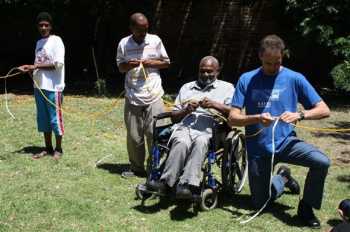For five years or so members of the Ocean View Association for Persons with Disabilities (OVAPD) in the southern part of the Cape Peninsula have been making bird-scaring lines for South African long liners and trawlers (click here).
This year a number of association members got to see albatrosses and other seabirds at sea for the first time on an ocean-going cruise south of Cape Town organized by BirdLife South Africa as part of its 2017 AGM “Flock at Sea”. BirdLife South Africa reports:
“When the members of the Ocean View Association for Persons with Disabilities (OVAPD) boarded the MSC Sinfonia, the joy and excitement on their faces was heart-warming. Until now the closest they had got to an albatross was the stuffed Wandering Albatross that the Albatross Task Force keeps for educational purposes. Not only was this the first time that many of them would be going out into the open ocean, but it was their first opportunity to see the birds that their bird-scaring lines are instrumental in protecting.
'A Sooty Albatross to the right!' the seabird guide shouted. There it was, the first albatross sighting for the team. Describing the experience, Ronald Stevens [of OVAPD] said, 'To see a live albatross is the most amazing thing, and for us to know that we help save them is wonderful.'
The proudest moment for the OVAPD team came when they were invited onto the stage at the start of the Albatross Task Force lecture describing the success that bird-scaring lines have had in reducing seabird bycatch. This was the formal recognition of their important contribution to seabird conservation.”

Members of OVAPD construct a bird-scaring line
Read more here and here on OVAPD’s contributions to seabird conservation.
Farther north in southern Africa bird-scaring lines for use on fishing vessels in Namibia are manufactured by the Meme Itumbapo Women’s Group, made up of hitherto unemployed women working from their headquarters “Bird’s Paradise,” in Walvis Bay (click here and here).
John Cooper, ACAP Information Officer, 28 June 2017

 English
English  Français
Français  Español
Español